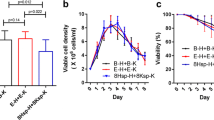Abstract
Human bcl-2 and bag-1 DNA were introduced into mouse hybridoma 2E3- O cells and expressed. The expression of bcl-2 in BCMGneo-bcl2 transfectants was confirmed by ELISA and that of bag-1 in pZeo-bag1 was confirmed by western blotting. In batch cultures, the over-expression of bcl-2 prolonged the culture period by 2 days and co-expression of bcl-2 and bag-1 prolonged the culture period by 3 days. The delayed increase in the dead cell number in culture of the bcl-2 and bag-1 cotransfectant indicated the additional antiapoptosis effect of bcl-2 and bag-1 cotransfection in comparison with the bcl-2 only transfection. The bcl-2 transfectants (2E3O-Bcl2) produced antibody twofold per batch culture in comparison with 2E3-O cells transfected with BCMGSneo (2E3O-Mock). Enhancement of this MoAb production was due to the improved survival of the cells and was not due to stimulation of antibody production rate per cell by Bcl-2 expression. And the bcl-2 and bag-1 co-transfectant (2E3O-Bcl2-BAG1) produced antibody approximately fourfold of 2E3O-Mock per batch culture. Enhancement of this MoAb production was due to the improved survival of the cells and was partly due to stimulation of MoAb production rate per cell in the non-growing phase by the cotransfection. The method to engineer hybridoma cells genetically with bcl-2 and bag-1 for increasing viability and productivity would be widely applied for improving antibody productivity of hybridoma cultures.
Similar content being viewed by others
References
Duke RC and Cohen JJ (1992) Morphological and biochemical assays of apoptosis, In: K Janssen (ed) Current protocols in immunology (pp. 3.17.1–3.17.16). Wiley, New York.
Duval D, Demangel C, Geahel I, Blondeau K and Marcaded A (1990) Comparison of various methods for monitoring hybridoma cell proliferation. J Immunol Meth 134: 177–185.
Itoh Y, Ueda H, Tsujimoto Y and Suzuki E (1995) Overexpression of bcl-2, apoptosis suppressing gene: prolonged viable culture period of hybridoma and enhanced antibody production. Biotechnol Bioeng 48: 118–122.
Makishima F, Terada S, Mikami T and Suzuki E (1992) Interleukin-6 is antiproliferative to a mouse hybridoma cell line and promotive for its antibody productivuty. Cytotechnology 10: 15–23.
Pettersson M, Jernberg-Wiklund H, Larsson, LG, Sundstrom C, Givol I, Tsujimoto Y and Nilsson K (1992) Expression of the bcl-2 gene in human miltiple myeloma cell lines and normal plasma cells. Blood 79: 495–502.
Perreault J and Lemieux R (1994) Essential role of optimal protein synthesis in preventing the apoptotic death of cultured B cell hybridomas. Cytotechnology 13: 99–105.
Simpson NH, Milner AE and Al-Rubeai M (1997) Prevention of hybridoma cell death by bcl-2 during suboptimal culture conditions. Biotechnol Bioeng 54: 1–16.
Singh RP, Emery AN and Al-Rubeai M. (1996) Enhancement of survivability of mammalian cells by overexpression of the apoptosis-suppressor gene bcl-2. Biotechnol Bioeng 52: 166–175
Suzuki E and Ollis DF (1990) Enhanced antibody production at slowed growth rates: experimental demonstration and a simple structure model. Biotechnol Prog 6: 231–236.
Takahashi K, Terada S, Ueda H, Makishima F and Suzuki E (1994) Growth rate suppression of cultured mammalian cells enhances protein productivity. Cytotechnology 15: 54–64.
Takayama S, Sato T, Krajewski S, Kochel K, Irie S, Millan JA and Reed JC (1995) Cloning and functional analysis of BAG-1: a novel Bcl-2 binding protein with anti-cell death activity. Cell 80: 279–284.
Terada S, Itoh Y, Ueda H and Suzuki E (1997) Characterization and Fed-batch Culture of Hybridoma Overexpressing Apoptosis Suppressing Gene bcl-2. Cytotechnology 24: 135–141.
Terada S, Fukuoka K, Fujita T, Komatsu T, Takayama S, Reed JC and Suzuki E (1997) Anti-apoptotic genes, bag-1 and bcl-2, enabled hybridoma cells to survive under treatment for arresting cell cycle. Cytotechnology 25: 17–23.
Terada S, Itoh Y and Suzuki E (1998) Establishing an apoptosis-resistant hybridoma cell line for usage in serum starvation culture. Kagaku Kogaku Ronbunshu 24: 161–164.
Tomei LD (1991) Apoptosis: a program for death or survival? In: LD Tomei and FO Cope (eds) Apoptosis: the molecular basis of cell death (pp. 279–316). Cold Spring Harbor Laboratory Press, Cold Spring, NY.
Tsujimoto Y (1989) Stress-resistance conferred by high level of bcl-2a protein in human B lymphoblastoid cell. Oncogene 4: 1331–1336.
Vomastek T and Franek F (1993) Kinetics of development of spontaneous apoptosis in B cell hybridoma cultures. Immunol Lett 35: 19–24.
Rights and permissions
About this article
Cite this article
Terada, S., Komatsu, T., Fujita, T. et al. Co-expression of bcl-2 and bag-1, apoptosis suppressing genes, prolonged viable culture period of hybridoma and enhanced antibody production. Cytotechnology 31, 143–151 (1999). https://doi.org/10.1023/A:1008080407581
Issue Date:
DOI: https://doi.org/10.1023/A:1008080407581




